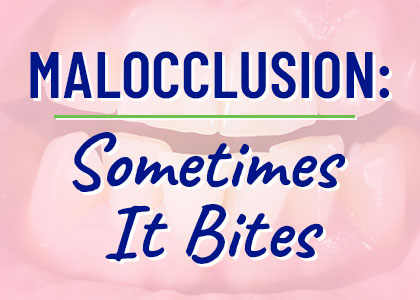Malocclusion: Sometimes It Bites
 Malocclusion is the dental term for misaligned teeth, a common condition affecting about 200,000 people in the United States every year. Many seek cosmetic solutions to feel better about their smiles, but there are also negative health consequences including pain and discomfort that result from improperly aligned teeth.
Malocclusion is the dental term for misaligned teeth, a common condition affecting about 200,000 people in the United States every year. Many seek cosmetic solutions to feel better about their smiles, but there are also negative health consequences including pain and discomfort that result from improperly aligned teeth.
The most severe cases may require surgical treatment beyond orthodontics, such as orthognathic (corrective jaw) surgery. Sugar Hill dentist, Dr. Chang would like to share some information about malocclusion, the effects it can have on oral health, and potential treatment solutions.
Occlusion & Bite
Occlusion refers to the alignment of your teeth, specifically the way your upper and lower teeth fit together. The way your upper and lower dental arches fit together is called your bite. If your upper teeth fit slightly over your lower teeth with the points of molars fitting the grooves of the molars directly opposite, you’ve got a healthy occlusion and bite. While the upper teeth keep us from biting our cheeks and lips, the lower teeth protect the tongue.
What Causes Malocclusion?
Malocclusion is often genetic. It presents in a variety of ways, ranging from differences in upper and lower jaw size to cleft lip or palate, which can result in overcrowded teeth or atypical bite patterns. Other causes of malocclusion include:
- Early childhood habits like thumb-sucking and prolonged bottle or pacifier use.
- Later childhood habits like nail biting, chewing pencils and pens, and swallowing disorders.
- Jaw misalignment after a fracture or other injury.
- Mouth or jaw tumors.
- Poor dental treatment with badly fitting dental appliances (fillings, crowns, etc.).
- Impacted, missing, abnormally shaped or extra teeth.
- Airway obstruction or mouth breathing (possibly resulting from allergies or enlarged tonsils).
What are the Negative Effects of Malocclusion?
When teeth are not aligned properly, daily functions such as breathing, eating, and speaking may become much more challenging. Pain and discomfort can lead to headaches and TMJ dysfunction. Sleep apnea is also a potential consequence of malocclusion. Even tooth decay and gum disease are more likely when dental irregularities exist, simply because there tend to be more places for bacteria to hide when teeth are crooked.
Treatments for Malocclusion
Depending on the type of malocclusion you have, different treatments will be considered, including:
- Bonding can reshape teeth that are not uniform in appearance.
- Extraction can correct overcrowding, allowing room for teeth to shift on their own.
- Orthodontics can correct the position of the teeth. There are many different options for braces today, from clear aligners to short-term and traditional braces.
Orthognathic Surgery
Orthognathic surgery corrects conditions of the jaw and face too severe to be treated with orthodontics alone, as correction requires surgical movement, modification, and realignment of bone. Conditions like these affect about 5% of the US population including, but not limited to, issues such as cleft palate, chronic jaw joint (TMJ) pain, facial injury, sleep apnea, and protruding or receding jaw.
While orthognathic surgery often improves a patient’s appearance, its true purpose is to solve functional problems with chewing, speaking, and breathing. Orthognathic surgery is often performed in conjunction with orthodontic treatment both before and after as part of a long-term treatment plan.
If you have any questions about malocclusion or orthodontic treatment, contact Sweet City Smiles today. Dr. Chang love to improve lives by creating healthy, confident, and functional smiles!
The content of this blog is not intended to be a substitute for professional medical advice, diagnosis, or treatment. Always seek the advice of qualified health providers with questions you may have regarding medical conditions.









